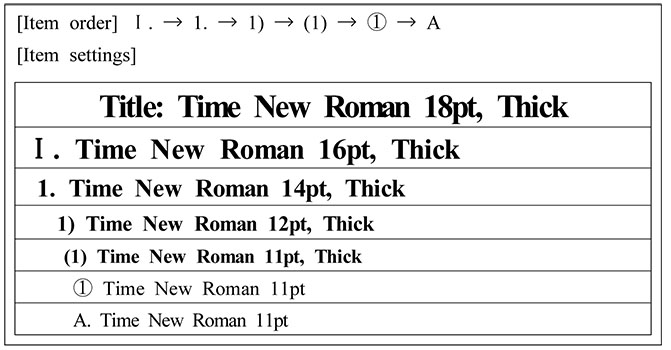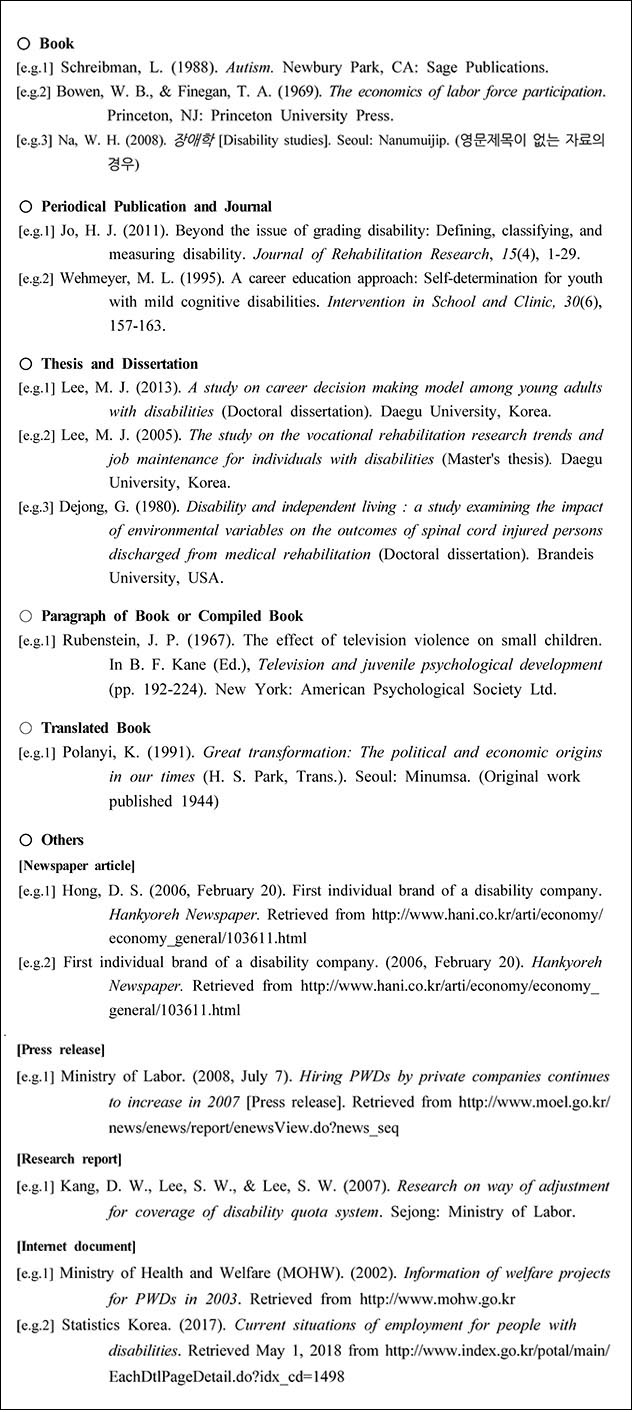1. Order of Manuscript (partially amended on December 2nd, 2016)
1. Manuscript title
2. Author(s)’ name and affiliation
3. Korean abstract (15~20 lines) and more than four key words
4. Body
5. Reference
6. English abstract (detailed orders are as follows: manuscript title in English, author(s)’ name and affiliation in English, 15~20 lines of English abstract, key words)
7. Appendix (if necessary)
2. Page Limit and format (partially amended on December 2nd, 2016)
1. Full-length manuscripts generally should not exceed 20 pages (including abstract, text, references, tables, and figures), and when exceeding, there will be extra charged at the publication stage.
2. Korean manuscript should be written via Korean Word Processor (Hangul 2010 or earlier version). English manuscript should be written via Microsoft word (MS Word).
|
Paper type
|
User defined (188×257mm)
|
|
Paper margin
|
Up : 24mm Down : 16mm
Left : 25mm Right : 25mm
|
Headers : 15mm
Footers : 16mm
bookbinding : 0mm
|
|
Character
|
Font : Time New Roman
Size(text, abstract, reference): 11pt
Size(table, figure) : 10pt
|
Width : 95%,
Spacing : 0%
|
|
Paragraph
|
Settings : Mix
Margin : Left 0pt, Right 0pt
Indent : 10.0pt
|
Spacing : Line spacing 160%
Above or below: 0pt
Minimum clear space : 100%
|
※ Above is the guideline of Korean manuscript and when English manuscript would be written in Microsoft word, font uses ‘‘Time New Roman’ and line spacing is applied with ‘single space’. And other settings shall be applied by above Korean manuscript guideline.
3. English manuscripts should be written via Microsoft Word. Times New Roman of 12 points and one inch margin (up, down, left, and right) are required. The entire paper must be double spaced. Manuscripts, including tables, figures and references should be prepared according to the Publication Manual of the American Psychological Association (6th ed; American Psychological Association [APA], 2010). Manuscripts should be written in simple, clear, and bias-free language.
4. This is the order of English manuscript.
① Manuscript title in English
② Author(s)’ name and affiliation (including nationality) in English
③ English abstract
④ Body and references in English
⑤ Manuscript title in Korean
⑥ Manuscript title, author(s)’ name and affiliation (including nationality) written in Korean
⑦ Abstract written in Korean
3. In the case of manuscripts or dissertation supported by research grants, this fact should be disclosed with the footnote in the first chapter of the manuscript.
● Example: This research has supported by ○○○○○○ on ○○○○ year.
● This paper partially utilized the data of the research of ○○○○○ on ○ ○○○ year.
● This research revises and summarizes the authors ○○○○○ doctoral dissertation.
4. Author(s)’ name
1. Author should indicate his / her name, and his/her affiliation (including nationality) next to it.
2. If there are more than two authors, their roles’ in research (the first author, co-authors, and corresponding author) should be clearly indicated.
3. Korean abstract (15~20 lines) and more than four key words
① The first and corresponding author should be indicated as follows. And co-authors should be listed in order of their contribution.
Hong Kil-dong¹, Lim Kuck-jung, Il ji-ma²
(¹: the first author, ²: corresponding author)
② The first author should be appointed by their co-authors’ consent. But, if the authors acknowledge that they have collaborated equally to their research, the name of the first author could not specified but all authors’ names could be indicated as co-authors.
③ When the first author and the corresponding author are same, his/her name can be indicated as the first author. In this case, the first author is recognized as a corresponding author.
5. Korean abstract (partially amended on September 13th, 2015)
1. The abstract is the summary of manuscript and should be written in 1/2 page(s)-long (15~20 lines).
2. Korean abstract should include At least 4 key words and be written as follows.
|
[Summary]
This study ...
■ Key words: people with disabilities, drinking problem, coexistence disorder, phenomenological study
|
6. English Abstract (partially amended on September 13th, 2015)
1. English abstract should be written in one or two page-long (15~20 lines).
2. The components and order of English Abstracts are as follows: Manuscript title, authors name, authors affiliation, summary, and key words.
7. Body (partially amended on September 13th, 2015)
1. The manuscript should be written in Korean or English.
2. Use proper noun when indicating persons’ or place’s names. Use Arabic number system, not Roman numbers, and metric system in measuring.
3. Numbering in the body should be typed as follows:

4. Tables and figures should be presented in font size (10pt). Each table or figure should be numbered as follows. The title of the table should be at the top and center of the table, and the title of the figure should be at the bottom and center of the figure.
● Example: <table 1>, <table 2>.......<figure 1>, <figure 2>
8. Citation
1. When cited and referred in the text, use parentheses and for explanation, use a footnote.
2. Author name and publishing time of reference should be presented and if necessary, cited page of a reference should be presented.
3. If the authors name is mentioned in the text, the publication year and the page number should be written in parentheses next to the authors name. If the author has western name, writing only last name is enough.
[Example 1] Goldfish (2005) is ......
[Example 2] According to a study by Smith (2002: 52) ....
4. If the authors name is not mentioned in the text, the authors name and year of publication shall be indicated in parentheses at the end of related citation.
[Example 1] According to a recent study (Golden Dragon, 2007) ....
[Example 2] .....reported as…..(Jinjadi, 2008).
5. If there are multiple authors, cite two authors’ names but when more than three, the first author’s name should be cited and put ‘et al.’
[Example 1] (Smith et al., 2005)
6. Between Korean authors’ names, put ‘,’ but foreign names, ‘&’ is used. But if author’s name is mentioned in the text, ‘and’ / ‘or’ can be used.
[Example 1] (Smith & Tom, 2005)
[Example 1] Smith and Tom (2005)
7. When citing more than two publications, use ‘;’.
Example 1] (Goldfish, gold fruit, 2002; Smith, 2003)
8. A rule of thumb basic principle is that no use of the secondary citation, but when it is not possible to find its original copy, use of secondary citation can be permitted with the clarification of the original citation.
9. References
1. Reference should be completed based on the proposed guideline (No.2-No.9) or APA (American Psychological Association) style.
2. Reference should be limited as mentioned or cited in the text and be listed in order of Korean, Chinese, Japanese, and Western languages. Western documents should be presented in alphabetical order.
3. The basic order of reference should be author (year), publication title, and publisher name.
4. If there are multiple references of the same author, they need to be presented in chronologically order and the author’s name should not be repeated from the second citation in describing as ‘’. And if there are multiple references by the same author in same year, ‘a, b, c’ next to the year needs to be added in the order of the quotation in the main body.
5. All authors names should be presented even there are more than two authors. In case of Western author, last name should be presented first, followed by a comma ‘,’, initial of his/her given name and put period mark ‘.’.
6. Between author (year) - title name - publishing company should be clarified with a period (.) as well as between multiple authors and journal name - volume - page number should be clarified with a comma (,).
7. English book and periodical publication, and English journal title and thesis should be presented in italic.
8. The first character of the titles of English book and thesis should be written in a capital letter and others should be written in a lowercase letter.
9. Followings are the example of reference notation.



